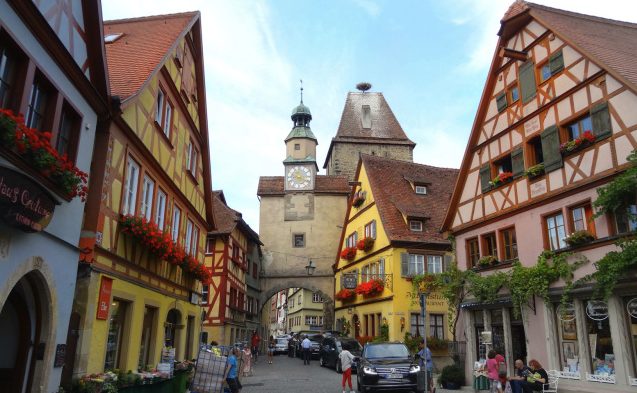Or were the Goths even ever there? Numbers and time tell the story. The invasions of Italy of which we know consist of four distinct events, two still to come in our story. The arrival of Alaric and his troops in the early 400s brought outsiders, and most of that group moved on in the 410s. Through the fifth century, other frights and fights, notably with the Huns, came and went, each leaving behind a few new settlers—and time passed. Theoderic appeared in the late 480s with the largest force ever until then to think of settling in Italy, and those soldiers and families spent the next fifty years, two generations, nestling into their homes. Italy was then to be attacked from Constantinople and the ruling government eventually, after a long and bloody battle we will have to steel ourselves to watch, overthrown. Theoderic’s regime had little effect on the ethnic makeup of the population, or its tendency to coalesce into one people. The last two invasions were equally barbaric. Justinian sent troops in the 530s and 540s in an act that was notionally Roman, but the troops themselves came from the same wellspring of Roman military force in the Balkans as Theoderic and his men. When, in the 560s, the Lombards arrived, they came as creatures of empire themselves, with no less obvious roots in all the obvious places, but we will see them settle mainly away from the cities, in numbers that cannot have been large. Of those four invasions, Justinian’s left the greatest demonstrable number of “barbarians” resident in Italy.
Of the northern people who came to the Mediterranean, whether we call them Vandals, Visigoths, Ostrogoths, Franks, Lombards, or eventually Slavs, all had more in common with one another and with the Romans than traditional narratives ever suggest. If there were any primeval forest dwellers in those communities, they were the ones their smarter, more acquisitive, and more ambitious cousins left behind. Immigrants are always like this, especially those who push across borders that resist them. By the time people like Theoderic’s followers find themselves in Italy, they were there not as barbarians but as Roman soldiers, bearers of the distinctive frontier culture of the north, to be sure, with styles of dress, religion, and speech that differentiated them from the settled southerners, but that made them nonetheless part of the same imperial community. They had their own officers, their own bureaucrats, and their own jargon customized tours balkan.
Latinless Goths in this period
If some of them did not speak Latin (though there is little or no evidence for Latinless Goths in this period), and if there was a Gothic language that they did speak, it was a heavy creole, with German roots but abundant romanization, and with ritual literary presence. The most splendid document of that Gothic tongue is the Codex Argenteus, the silver codex preserved today in the library of Uppsala University. Only a fragment of what it was, the manuscript contains passages of the four gospels written on purple-stained vellum in letters—quite beautifully and regularly inscribed—of silver and gold.4 It was written in Ravenna as a treasure that handsomely displayed the splendor of Gothic civilization, but absolutely nothing about its physical form owed anything to any source other than the Mediterranean. The manuscript may have come from the workshop of a man with a Gothic name, Wiliarit, known to have produced handsome Latin manuscripts in Ravenna as late as the dreary war year of 551. One of his products was a copy of Orosius’s History against the Pagans—a seemingly authorized Christian version of all of Roman history as seen by a disciple of Augustine in the early fifth century. Gothic culture in this period was not a counterculture but a badge of pride and belonging, deriving all its meaning from its Roman setting.
Many who know nothing of the facts of the matter still deeply and instinctively believe an alternative view—that these people represented an irreducible and uncivilizable injection of barbarism into Rome, for good or ill. Nineteenth-century nationalism nurtured this confidence, as did the pride of German scholars who saw in these figures their own cultural ancestors. We should be wary of such psychological projection and self aggrandizement. Sober and reasonable scholars took the perfumed sixth- century Latin texts of Ennodius, Cassiodorus, and Avitus and published them in the “more ancient authors” series of the Historical Monuments of Germany (Monumenta Germaniae Historica), a huge collection of impeccable scholarship. Felix Dahn, one of the most serious scholars of this period, known for a long series of volumes, Kings of the Germans, also produced one of the most successful historical novels of the time, A Fight for Rome (Ein Kampf um Rom), which was later known to be a favorite of the emperor Wilhelm at the time of World War I. Its title evokes both the Kulturkampf of nineteenth-century Prussia and the better-known Kampf of a later German tyrant. In it, the confident nationalism and racism of the nineteenth century proclaim themselves through the voice of a Gothic leader: “So where is this ‘mankind’ you speak of? I don’t see it. I see only Goths, Romans, Byzantines! A ‘mankind ’over and above these peoples, somewhere in the air, that I don’t recognize. I serve mankind when I love my own people (Volk). I cannot do otherwise!”
Read More about Colosseum afterward








